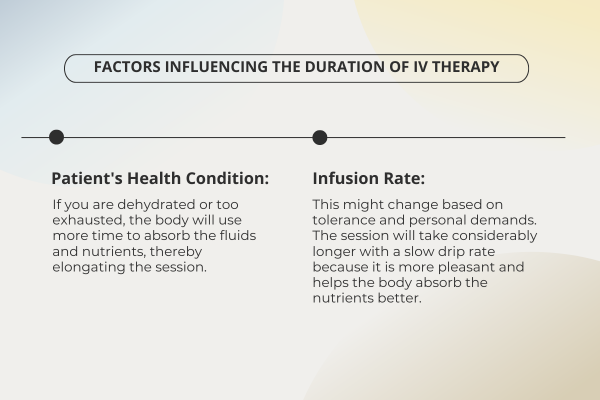How Long Does IV Therapy Take, and What Factors Affect Its Duration?
The duration of IV therapy typically ranges from 15 to 90 minutes, depending on:
Type of Treatment: Basic hydration IVs take 15–30 minutes, while immunity or beauty drips last 60–90 minutes.
Patient’s Health Condition: Dehydration or fatigue may extend the session.
Infusion Rate: A slower drip rate ensures better absorption but takes longer.
Effects can be felt within hours, lasting from days to weeks. With its quick benefits and tailored treatments, IV therapy remains a fast and effective wellness solution.
Among the several health benefits, IV therapy has many advantages. Fluids, medications, and nutrients are introduced directly into the bloodstream from where they will be absorbed very fast, bypassing the digestive system. This therefore suits the treatment of dehydration, energy boosting, immune function enhancement, and several diseases including migraines and nutritional deficiencies.
Quick responses are also realized in emergency cases like severe dehydration and electrolyte imbalances. This makes IV therapy both versatile and valuable in medical and wellness settings since the treatments can be tailored to address individual needs. In Dubai, there are specialized clinics offering high-quality IV therapy services, ensuring that treatments are both effective and safe.

Duration of IV Therapy: How Long Does It Take?
In the current fast-paced world, where people have very little time for themselves, everyone is eager to get quick and easy health solutions. One such current vogue treatment is IV therapy. It has become an increased favorite choice among many for energy boosts, hydration, or skin health. But the most common question that one asks is: How long does IV therapy take?
In this guide, we will break it down, look at the reasons that determine the time it takes, and give you a couple of insights into what periods can the benefits take, helping you decide if it is worth it, while IV therapy takes too much time. Additionally, you might be interested in learning about NAD IV therapy, a specialized treatment that harnesses the healing potential of NAD+ to support cellular health and boost energy levels.
Understanding IV Therapies and Their Benefits

IV therapy stands for intravenous therapy, where a specially blended mix of vitamins and minerals is introduced directly into the blood. Such an administration route allows for a very fast absorption and complete bypass of the gastrointestinal system. It means that one feels the results more quickly and attains them more efficiently. From hydration and immune support to skincare and energy improvement, the methods are applied in almost everything.
What are the Most Common Minerals and Vitamin Mixtures Contain in IV Therapy?
One of the most popular IV therapy mixture is considered to be Myer’ Cocktail, which was initially administered for similar treatments back in 1970 by John Myers. The mixture contains assorted dosage of Magnesium, Calcium, Vitamin B6, Vitamin B12, Vitamin B5, Vitamin B Complex, and Vitamin C.
There are some other types of IV therapies that are used for certain treatments, including;
- IV Magnesium Sulfate, administered as a substitute for nebulizer for children with acute Asthma,
- IV Selenium, used for critically conditioned patients while taking mechanical ventilation,
- IV Vitamin C, consumed in high dosage by those living with cancer. Yet, this treatment has not been proven effective by the researcher.
How Long Does an IV Therapy Session Take?
A usual IV treatment usually takes 15 to 90 minutes, depending on the type of treatment administered, the health condition of the person, and the cause for its administration. An example is the basic hydration IV, which can be as short as only taking 15 to 30 minutes, but more complicated ones like those for the enhancement of immunity and work related to beauty take a longer time up to between 60 and 90 minutes.
Among the several health benefits, IV therapy has many advantages. Fluids, medications, and nutrients are introduced directly into the bloodstream from where they will be absorbed very fast, bypassing the digestive system. This therefore suits the treatment of dehydration, energy boosting, immune function enhancement, and several diseases including migraines and nutritional deficiencies. Quick responses are also realized in emergency cases like severe dehydration and electrolyte imbalances. This makes IV therapy both versatile and valuable in medical and wellness settings since the treatments can be tailored to address individual needs.
Factors Influencing the Duration of IV Therapy

How long it will take is highly dependent on the complexity and makeup of the stuff that is running in the IV. While a simple saline hydration IV is relatively quick, a nutrient-, antioxidant-, and electrolyte-heavy IV drip will take a much longer time.
- Patient’s Health Condition: If you are dehydrated or too exhausted, the body will use more time to absorb the fluids and nutrients, thereby elongating the session.
- Infusion Rate: This might change based on tolerance and personal demands. The session will take considerably longer with a slow drip rate because it is more pleasant and helps the body absorb the nutrients better.

How Long Do the Effects of IV Therapy Last?
IV therapy can have effects that range from a few days to several weeks, depending on the type of treatment used and the requirements of your body. Certain benefits, like increased vitality or complete hydration, might manifest within hours and persist for as long as two weeks. Others, including more specialized skincare or immunological support therapies, may be beneficial over a longer period—up to several months.
In general:
- Immediate Effects: It is possible to observe increased hydration, lessened fatigue, and heightened energy by treatment within 12–24 hours.
- Short-Term Effects: These effects can be observed in most individuals between 4 days and 2 weeks.
- Long-Term Benefits: Some benefits, like enhanced immunity or continual energy levels, may extend to weeks or even months if infused with the right nutrients.
The Complete Process of an IV Therapy Session
Upon entering the IV therapy session, you will be first checked for your health condition and hydration level. Once the combination of nutrients that your body needs is determined, the IV drip is prepared according to that. Next, a little butterfly needle will be inserted into a vein—usually in your arm—and the infusion will start.
This entire process is close to painless, allowing you to relax while the drip works its magic. It’s essential to consider how often should you get IV therapy; frequent treatments may increase the risk of side effects and should be discussed with a healthcare professional to determine an appropriate schedule.
How Long Do the Fluids Stay in Your System?

IV fluids absorb relatively well into the system. The average length of time it takes for the fluids to flow through you and start getting flushed out of your body is a few hours. However, the vitamins and nutrients that are introduced via IV therapy can stay in your system much longer to promote good health and well-being.
In terms of flushing the fluids themselves, it takes an average of 2 to 3 hours, though the hydration and nutritional boosters persist far longer. It’s important to be aware that IV therapy can have side effects, such as infection at the injection site, vein inflammation, or more serious complications, so it’s crucial to monitor for any adverse reactions.

Are IV Drips Worth the Time?
IV therapy is becoming more and more popular due to its quick and efficient results. The simplicity of a quick 30 to 90-minute session can make a great difference for those trying to improve their attractiveness, maximize their health, or just recover from exhaustion. Furthermore, consistent therapy—typically advised once a week for four weeks, followed by monthly maintenance—can result in cumulative and long-lasting health advantages.
If you’re also interested in enhancing your appearance, you might want to explore the best non-invasive fat removal methods, which offer effective alternatives to traditional liposuction.
How long does an IV take? Conclusion
IV therapy offers flexibility and effectiveness regarding health and well-being, as procedures may take 15 minutes to 90 minutes. This enables one to get almost immediate benefits lasting several days to weeks after treatment and becomes quite attractive for those looking for fast and result-driven treatments. Knowing the timeline is important in deciding with the most information, whether a first-time or regular user of IV therapy, and incorporating this treatment into your routine seamlessly.





